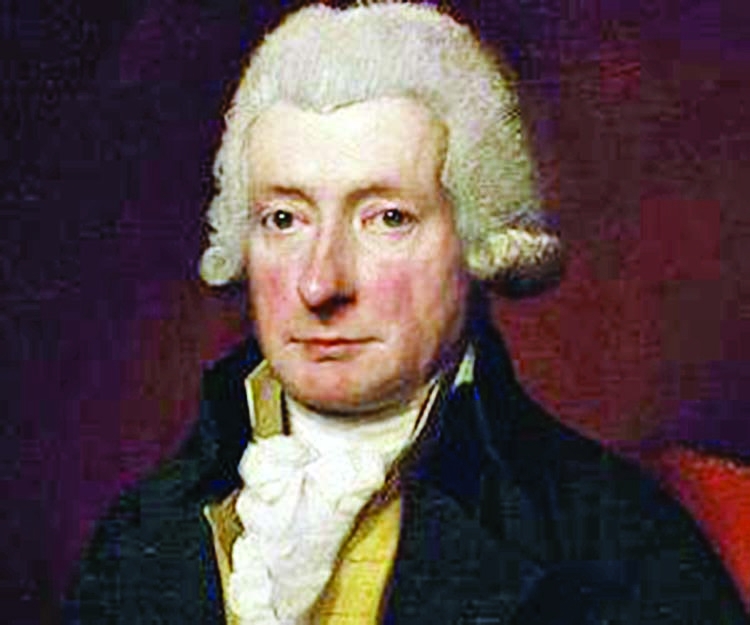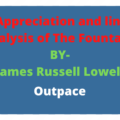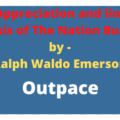THE POEM
To grass, or leaf, or fruit, or wall, The snail sticks close, nor fears to fall, As if he grew there, house and allTogether. Within that house secure he hides, When danger imminent betides Of storm, or other harm beside Of weather. Give but his horns the slightest touch, His self-collecting power is such, He shrinks into his house, with much Displeasure. Where'er he dwells, he dwells alone, Except himself has chattels none, Well satisfied to be his own Whole treasure. Thus, hermit-like, his life he leads, Nor partner of his banquet needs, And if he meets one, only feeds The faster. Who seeks him must be worse than blind, (He and his house are so combin'd) If, finding it, he fails to find Its master.
Word meanings related to the Poem
- Imminent – overhanging
- Betides – something that is about to happen
- self-collecting – self-possession
- Shrinks – to become smaller
- Displeasure – with much annoyance
- Dwells – to leave or continue in a given conditions
- Chattels – personal belongings
- Treasure – a collection of precious things
- Hermit-like – avoiding the company of other people; solitude
- Banquet – a sumptuous feast especially
About the Poet

image source-The Asian Age
Born in 26th November 1731, in Berkhamsted, Hertfordshire, England, William Cowper was one of the famous poets of his time. He started to change the nature of 18th-century poems based on nature by the writing of regular lives and scenes of the English countryside. His father, John Cowper, rector of the St. Peter Church, was also a poet. He was also excelled at the interpretative and translation of Latin and wrote many verses of his own.
Cowper continued his education in Westminster School, after moving from one school to another. He had written numbers of anti-slavery poems. He was a good friend of Newton, who was a devoted anti-slavery campaigner. Cowper got influenced by Newton and wrote one of his famous poems, “ The Negro’s complaint ” ( 1788 ).
Cowper also wrote several other less well-known poems based on slavery in the 1780s, which attacked the mentality that slavery was economically viable. William Cowper died on April 25, 1800.
Title of the Poem
In the poem, the port minutely describes the private life of the Snail. The Snail, who is a very small creature, which sticks near to the grass, leaf, walls, or fruits, is well-satisfied with his own wealth, without depending on others. The Snail only relies upon its own energy, will and honesty which make him fearless and to face all hardships. So the title of the poem is appropriate, as the whole poem dwells with the snail and it’s hardships in his life, and also it’s uniqueness in his character.
About the Poem
The poem, The Snail, begins with a simple observation, which turns to a question whenever or not the snail has ‘fury’ before weighing up the whole adventure with a theoretical outline, not a definitive solution. The whole poem is made up of five complete sentences, where each line, slowly flows into the next, where the inflection a mirror of the physical progress is reflected by the snail.
No doubt that the snail is a creature of anti-sensibility, but in the most glamorous sense. It means, the snail is not one of the scrambling crowd, who is fearless to have communication with others by making their way conventionally through life, alone brother in positivity. Instead, the snail is expert in sorting out things. The snail us not homeless; he has his own house to live in, which not only satisfies him but stands as strong supremacy of power. Not being an unsocial kind, the snail is quite energetic in nature. We know that sensibility can represent as ‘for’ or ‘against’ interrogation into the social, as it builds it’s own disaster as early as it finds a solution–which is the same case as that of The Snail in the poem.
The snail is a very tiny creature, who can easily stick with the grass, leaf, fruit or wall. As he grows on his own shell, he does not fear to fall. The poet feels secure, within his own house, from any danger of storm or other harms. He dwells alone always and feels satisfied with the little treasure he belongs. The poet tries to live his life like hermits, who is out of any kinds of needs from any partner, unless he meets someone, just to feed.
Background of the Poem
The poem, The Snail, was written by Cowper in Norfolk, where he spent his last days after his last displacement from his home.
The poem describes Cowper’s need to generate a personal attractiveness during his time in Norfolk, and the reason for forming this poem, compared to the creation of a protective shell at an endangered stage in Cowper’s work and life as well. The main reason of writing this poem is that, it originates an inner comfort and the feeling of home-like, which cannot be taken away from him. The phrase ‘house and all’ depicts not the temporary places, where the snail affix itself, but the one which is surrounding and is the part of his own body.
The poem, ‘Shrinking Snail ’ by Shakespeare, also events some influence on Cowper’s ‘ The Snail’, indirectly. In the poem, The Snail, the tiny snail is highlighted into such abiding and sympathetic focus, which to ‘extinguish’ takes on the character of the reader.
- Perform Online Pokies Regarding Real Money Lucky Cash Codes No Max Cashout No Down Payment Bonuses
- Uptown Pokies Mobile Online Casino Regarding Australian Participants
- Find Out Uptown Pokies On Line Casino And Carrier Your Self A Massive $8,888 Plus Three Hundred And Fifty Spins To Take Enjoyment In Top-tier Online Pokies Gaming!
- Discover Typically The Amazing Provides At 500 Online Casino Catch The Chance Now!
- Leading Jili Slot Machines 777online On Range Casino Within Generally The Philippines Maxabout News
Line by line analysis of the Poem
Stanza 1
To grass, or leaf, or fruit, or wall, The snail sticks close, nor fears to fall, As if he grew there, house and all Together. Within that house secure he hides, When danger imminent betides Of storm, or other harm besides Of weather.
Here, in the Stanza 1 of the poem, the speaker describes the livelihood of The Snail. The speaker hives a keen observation of the snail as it hunts for food in the dark. As it was raining and also the earth has grasses, which were wet. But the snail, notwithstanding, creates an imaginary luminous path, which stands against the darkened night.
As we know that, a snail is a hermaphrodite animal, with a single muscle, it snails into the dark green night. But he is not alone as there is a human (the speaker) who is watching minutely his actions and thus recording them as inspiration to humankind.
The speaker describes in the poem about the snail, with a few simple but image-rich descriptions, who is out for in search of food. The grass due to heavy rain was wet and heavy and bending over the snail’s head as it snails across the grass.
Stanza 2
Give but his horns the slightest touch, His self-collecting power is such, He shrinks into his house, with much Displeasure. Where'er he dwells, he dwells alone, Except himself has chattels none, Well satisfied to be his own Whole treasure.
The snail has his own horns -tentacles -which are stalks to help the snail to have the sense of sight and taste. For the first time, in the poem, the speaker represents himself as ‘I’, in order to highlight the whole human world with its biddings on knowing and communicating and decreasing.
According to the speaker, it is the energy of snail that must surely carry some sorts of emotions along with the snail. In the fifth line, there is a very unusual question, where the speaker wonders about the snail’s fury. It is quite basic for the speaker’s astonishing question ‘ What is snail’s fury? ’ Do really a snail have fury– all that suppressed dreams implies that there should be somewhat free space.
Rather, this question implies human traits onto the impulsive snail. ‘Fury’ is an emotion, which only humans can feel.
The stalks on the snail’s head are being described as the ‘horns’ in the first line of the second stanza. The snail’s stalks are barely stirring or moving when he moves for his ‘hunt’. The speaker, sometimes, wonders and thus comes to somewhat conclusion that there must be something which drives the snail to move forward. But, being a human being to observe, he is saturating a non-human creature i.e., The Snail, with some human characteristics.
Stanza 3
Thus, hermit-like, his life he leads, Nor partner of his banquet needs, And if he meets one, only feeds The faster. Who seeks him must be worse than blind, (He and his house are so combin'd) If, finding it, he fails to find Its master.
All the previous observations and ideas which glows, into the final sentence, refer to the enjambment between these stanzas.
The speaker now gets into an imagination about what he would have made of the broken white trail, if he had not seen the snail and his movements, before.
All the admiration, that devoted motion onwards, has disappeared somehow, by leaving only the dry sludge. Whereas, the speaker, who wants to understand every single desire of that of the snail, knows the isolation of the two worlds, –one that of the hermaphrodite creature and another, that of the human beings.
The speaker shows empathy for that small, humble animal, but also a strong desire to know, how this small snail carries around in such a way, throughout the world. The speaker’s initial impartiality gradually changes into puzzlement and admiration.
Here, in this stanza, the speaker represents a hypothetical scenario. The speaker describes the snail as a loner and who likes to be itself. The snail loves to lead a life like a hermit blissfully. The one who tries to long for the snail must be worse than a blind.
Here, the speaker explains, how the snail leads its life. Despite having no friends, family, and dear ones, the snail has only food to eat, that also when he gets some. It carries its life, like that of the hermits by staying its whole life inside its hard shell, which is also it’s home. But, rather than human beings, the snail wouldn’t be able to see his family or anything, except darkness, in his house.
Structure of the Poem
This poem consists of three equal stanzas, and each stanza bearing three complete lined, of totalling 18 lines throughout the poem. The three-stanza poem is being separated into sets of six lines, known as sestets. Though these sestets do not follow a specific rhyme scheme Or metrical pattern, the lines are almost similar in length and the number of the syllabus are also present in each.
There is no fix rhyming scheme in this poem as such, but some lines are connected through para-rhyme i.e., aaab, cxcb, dddb, eeeb, cccb, fffb.
for example, “wall”, “fall”, “all”, “together”.
Also Punctuations, here and there, causes the reader to pause, again and again, which signifies just as that of the snail might do, in its real life.
Literary Devices in the Poem
Considering ‘The Snail’, by William Cowper, the poem contains the following poetic devices:–
Alliteration
- The occurrence of the same letters or sound at the beginning of adjacent or consonant sounds in successive syllables.
Categories of alliteration assimilated in this poem include,
- The snail sticks close;
- nor fear to fall;
- If finding it, he fails to find;
Imagery
- As a literary device, imagery consists of explanative language and also uses symbolism to the work. It draws on the five senses, – sight, sound, taste, smell, touch.
for example,
- touch: Give but his horns the slightest touch;
- taste: his banquet needs,… .. … only feeds;
- sight: must be worse than blind;
- touch: the snail sticks close…
Metaphor
- A figure of speech, in which a phrase o a word used to an object or action, to which it is not literally applicable.
- he and his house are so combined;
Simile
- It is a common poetic device, where the subject is being described by comparing it to another object or subject, using ‘as’, or ‘like’, in the poem.
such as,
- Hermit-like;
The theme of the Poem
- A lesson about Life:— Through this poem, the poet wants to bring out the lesson about human life or the statement about human nature. By choosing the displacement of ‘The Snail’, the Cowper highlights on the physical world, where the slow alterations of shape parallel the sensuality of being a human being, understanding the body as it is habituated to its the environment. Cowper, in this poem, takes us into the private world of a snail, where the snail is seemed to lead a self-sufficient life.
Honesty can also be another habitude component of the life of the snail. He is well-satisfied with his own treasures and does not urge for more.
- Being fearless:— In the poem, it is being reflected that The Snail never fears for anything whatever the situation is. He is having his self-esteem and courage to face all the hardships that come to his life, slowly. He can give his best to protect himself from any kind of danger or in order to run long, to get his food in order to survive. The poem, ‘ The Snail ’ by William Cowper is a free-verse poem, which consists of three equal stanzas, of totalling 18lines, where each line consists of 7 syllables.
- Free Verse poem:— The poem, ‘ The Snail ’ by William Cowper is a free-verse poem, which consists of three equal stanzas, of totalling 18 lines, where each line consists of 7 syllables. There is no fix rhyming scheme in this poem as such, but some lines are connected through para-rhyme —
- wall/fall…
- hides/besides…
- touch/such…
- alone/none…
- leads/needs…
- blind/find…
- together/displeasure…





